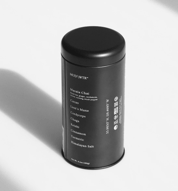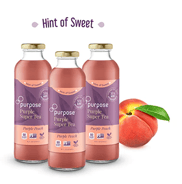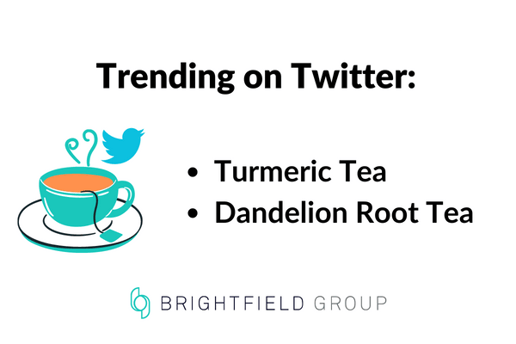Tea is one of the oldest and most popular beverages in the world, so why is the coffee and tea market growing? Trends in the coffee and tea category show consumers are seeking out healthier alternatives to sugary drinks.
As a wellness innovator, understanding the latest tea trends and consumer preferences around tea products can be a valuable tool for developing new offerings and engaging with buyers. In this blog post, we'll explore data from Brightfield Group’s social listening platform on tea products and highlight some key insights and trends.
Tea Products Trending Online
Tea comes in many varieties, from traditional black and green teas to more exotic blends like oolong and herbal teas. There is also the distinction between traditional brew teas and the ready to drink varieties.
Some of the most popular types of tea products on the market include:
- Green tea: A light and refreshing tea with a slightly bitter taste. Data from Brightfield Group’s consumer insights platforms shows those who have bought tea in the last year tend to prefer this variety.
- Black tea: A strong and bold tea with a rich flavor. 20% of tea drinkers reported purchasing this type in 2022, making it the second most popular tea among that group.
- Herbal tea: A caffeine-free tea made from herbs, flowers, and spices. This is the third most popular type of tea, with 16% of consumers purchasing it in 2022.
- Matcha tea: A finely ground green tea that has been used in tea ceremonies for centuries. As consumers continue to seek out exotic products, Matcha tea is likely to remain popular.
Although the teas above are currently the most popular among consumers, there are other tea varieties quickly growing in popularity. More and more consumers are chatting online about wellness-focused teas.
Trending teas on Twitter include turmeric tea (which has been known for many years to have anti-inflammatory properties), Dandelion Root tea—a traditional diuretic used in Chinese medicine —and Tea blends with added adaptogens. Brands take note: these teas are still fairly new for American consumers, so there is plentiful opportunity to innovate in the space.
Tea vs Other Functional Beverages
While tea is potentially the world's oldest wellness beverage, a new class of drinks—functional beverages—has emerged in recent years. Functional beverages are nonalcoholic drinks that have been fortified with wellness ingredients, such as minerals, vitamins, amino acids and adaptogens. These beverages may include speciality waters, sports drinks, energy drinks and fortified fruit juices and drinks mixes.
Social media consumer insights shows functional beverages such as coconut water, electrolyte water and prebiotic drink mixes are seeing large increases in the number of social media posts about the products. Prebiotic soda in particular has had a share of voice increase of over 5% in the beginning of 2023.
In comparison — although traditional tea options such as black and green tea still lead social media conversations — wellness-focused tea blends are growing in prominence. Green tea extract, Dandelion root tea and Turmeric tea are among the teas growing in share of voice on social media.
While tea is not the fastest-growing functional beverage category, its sustained popularity suggests that it will continue to be an important player in the market. Despite the wealth of innovation in the functional beverage space, Brightfield consumer insights reveal that consumers are still buying more tea products than other functional beverages.
Brewing Up A Social Media Presence
Social listening data can provide valuable insights into how consumers talk about tea online. A recent analysis of online conversations around tea revealed that consumers often discuss the health benefits of tea, including its ability to boost the immune system, aid digestion, and reduce stress. Other common topics of conversation include exercise, sleep, and sustainability.
According to social listening data, green tea and herbal tea are seeing the most traction on social media. Consumers are particularly interested in the health benefits of green tea, while herbal tea is popular among those looking for caffeine-free alternatives. Brands that specialize in these types of tea products may want to focus their social media efforts on promoting their unique health benefits and flavor profiles.
Hashtags are an important tool for brands to engage with consumers and increase visibility on social media. Some of the most active tea product hashtags include: #organic, #detox, #wellness, #teatime, #greentea, #herbaltea, #tealover
Tea Brands Redefining the Industry
New exciting brands are making waves in the tea industry with innovative products and marketing strategies. Tea brands such as NoonBrew and MUD\WTR are leading the way on creating innovative tea blends with additional wellness benefits.
NoonBrew combines organic tea with 19 superfoods that help with natural energy, focus, digestion, and deep sleep. By sharing recipes and engaging with customers on social media, the brand has built a strong social media presence.
 With ingredients such as cordyceps, lion's mane mushrooms, and valerian root, MUD\WTR brands itself as a coffee alternative made with organic ingredients. By building a robust influencer marketing strategy and highlighting their products' adaptogenic properties, MUD\WTR has also built a significant social media presence.
With ingredients such as cordyceps, lion's mane mushrooms, and valerian root, MUD\WTR brands itself as a coffee alternative made with organic ingredients. By building a robust influencer marketing strategy and highlighting their products' adaptogenic properties, MUD\WTR has also built a significant social media presence.
Ready to drink tea brands are also making significant strides with innovative tea offerings. For example, Happy Being makes antioxidant-packed tea drinks that are designed to boost immunity and promote healthy inflammation. These functional beverages offer a great alternative for taste and health conscious consumers.
Meanwhile, Waku’s prebiotic herbal teas offer a "unique botanical blend" that contains 6g of prebiotic power to maximize gut-health benefits. These ready to drink teas prioritize the digestion benefits of tea.
 Alternatively, Purpose Purple Tea features a new innovation in tea — the purple tea leaf. With up to 50% more antioxidant activity of green or black tea, Purpose Purple Tea offers a more potent antioxidant-packed tea. This brand has built a loyal following with their creative flavor combinations and mission-driven business.
Alternatively, Purpose Purple Tea features a new innovation in tea — the purple tea leaf. With up to 50% more antioxidant activity of green or black tea, Purpose Purple Tea offers a more potent antioxidant-packed tea. This brand has built a loyal following with their creative flavor combinations and mission-driven business.
Pouring into the Future
As the global tea market continues to grow, there are many opportunities for wellness innovators to develop new and exciting tea products. Social listening data offers a wealth of insights for innovators in the tea industry.
With consumer insights panel data showing people are drawn to tea for its health benefits, brands can engage with them through social media strategies that promote unique flavor profiles and functional health benefits. With opportunities for functional, ready-to-drink, and sustainable tea products, the future of tea looks promising for those willing to take the plunge.
Published: 4/26/2023





